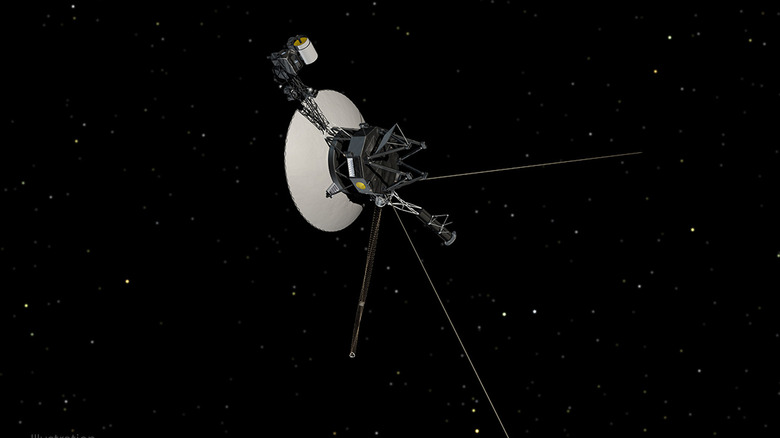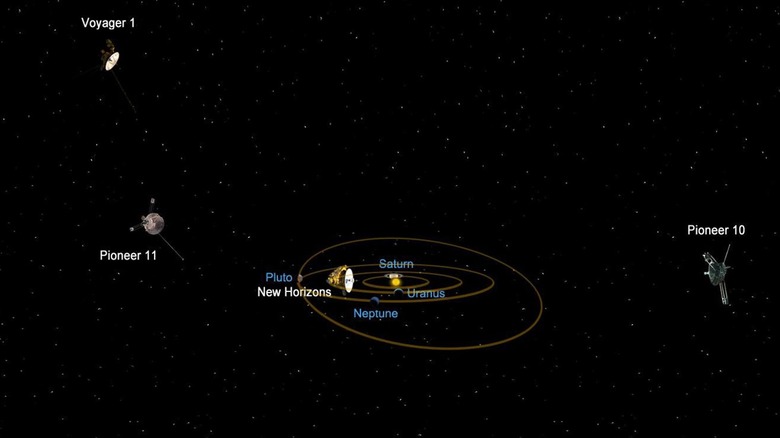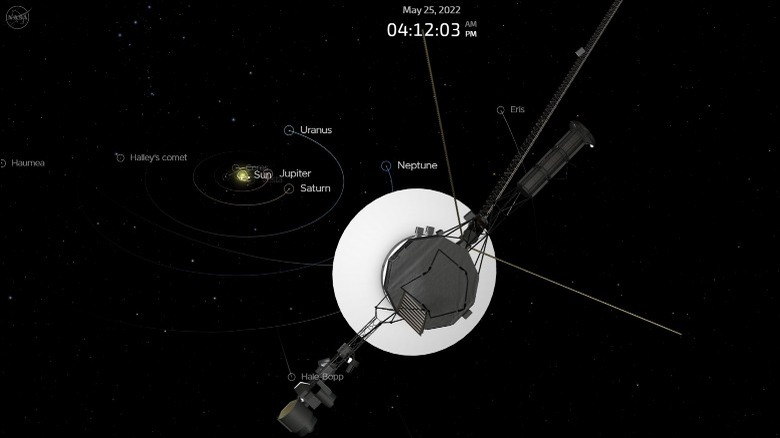Here's Why Scientists Are Worried About Voyager 1
Voyager 1 — the 45-year-old probe that has gone deeper into space than any other man-made object — is presenting NASA with a unique mystery. NASA's Jet Propulsion Laboratory (JPL) has revealed that Voyager 1 is transmitting "invalid" telemetry data. The spacecraft is otherwise operating normally, collecting the data it is supposed to and receiving and executing commands from Earth, but it is sending mysterious "readouts from the probe's attitude articulation and control system (AACS)," according to a NASA JPL news post. According to NASA's JPL, what's being shown in the readings and data this week does not reflect what is actually happening onboard the craft out in the far reaches of space.
The AACS is critical for the Voyager 1 mission. It controls the spacecraft's orientation and, by extension, the antenna used for communication with Earth. "The data may appear to be randomly generated or does not reflect any possible state the AACS could be in," NASA JPL added in that same announcement. Voyager 1 is 14.47 billion miles from Earth and clocks 38,000 additional miles every hour as it moves through interstellar space beyond our solar system.
Throughout its mission, 6 of Voyager 1's 10 instruments have been switched off, per NASA's Voyager status page. NASA explains that, fortunately, the AACS irregularity has not triggered Voyager 1's fault protection systems and consequent "safe mode." The spacecraft's signal has not weakened either, and its antenna still points towards Earth. Engineers are now investigating the invalid data to understand if the failure originated from the AACS or another system on the spacecraft. JPL clarified that the severity of the issue is not fully understood, nor does it know whether the mission will be affected.
How will NASA fix Voyager 1?
"A mystery like this is sort of par for the course at this stage of the Voyager mission," Suzanne Dodd, project manager for Voyager 1 and 2, said. "The spacecraft are both almost 45 years old, which is far beyond what the mission planners anticipated."
Every year that goes by, Voyager 1 loses about four watts of the total electric power it generates. In the past, NASA shut down several systems, subsystems, and even heaters to preserve energy for more important components. NASA's Jet Propulsion Laboratory engineers have to work around the AACS anomaly with this limited power supply. When NASA encounters this type of problem in distant spacecraft, the Voyager team works to solve it through software updates or deploying redundant systems.
"We're also in interstellar space — a high-radiation environment that no spacecraft have flown in before," said Dodd. "So there are some big challenges for the engineering team. But I think if there's a way to solve this issue with the AACS, our team will find it."
In 2017, Voyager 1 lost its primary thrusters due to degradation, prompting the team to switch to the spacecraft's backup thrusters, which fired despite being inactive for over 37 years. When software updates or redundant systems do not do the trick, NASA gets even more creative and learns to adapt to the anomaly — something it may need to do if it can't figure out the cause of this problem with the Voyager 1's AACS.
You can track Voyager 1 in real time, too
NASA's Jet Propulsion Laboratory provides all the details an amateur astronomist might want on both Voyager 1 and Voyager 2 on their Voyager mission status tracker homepage. With the information the JPL makes available, you can take a peek at the Space Flight Operations Schedule (SFOS) for both Voyager 1 and Voyager 2, with a record of scheduling and data going back to the year 1994. f
You can track Voyager 1 and Voyager 2 by mission elapsed time, distances from the Earth and our nearby Sun, and you can visualize positions with the NASA Eyes on the Solar System app. This app is powered by NASA's Eyes as produced by the Visualization Technology Applications and Development Team at NASA's Jet Propulsion Laboratory at the California Institute of Technology, tracking Voyager 1, Voyager 2, and a wide variety of spacecraft exploring the universe.
You could also take the entertainment route and follow the official Twitter account of Voyager 1, where the craft recently wrote, "Do you ever feel misunderstood? My team is investigating an issue with my data. Even though I'm sending signals and operating normally, some data readouts don't exactly match what's happening out here. While they investigate, I'll keep doing my thing."
As this craft continues to move at a speed of 37,914 mph relative to our Sun, 14.47 billion miles away from Earth, we're crossing our fingers that it keeps its jolly attitude until the bitter end.


